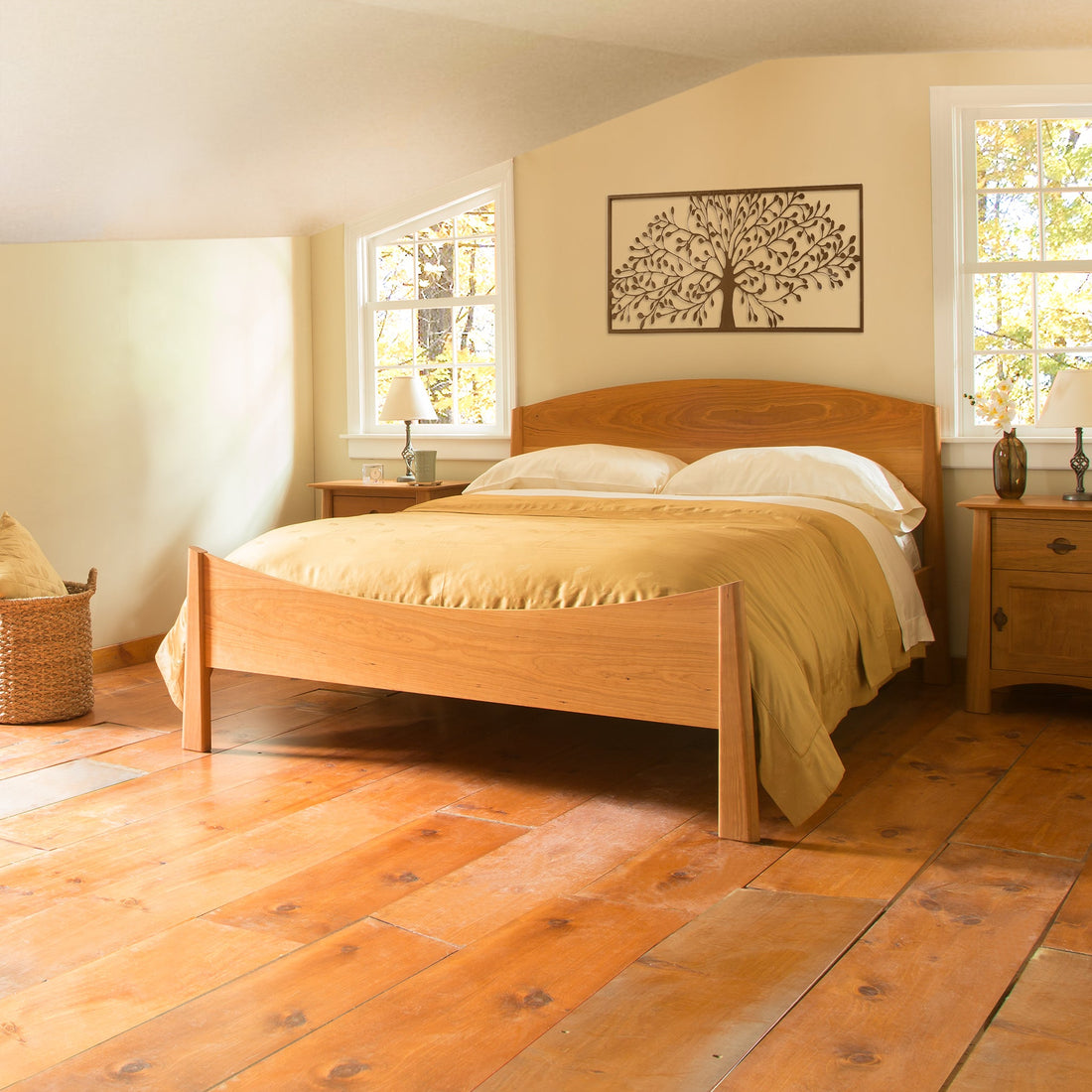Figured maple wood is a rare and highly prized material in the world of custom furniture, known for its intricate grain patterns and natural beauty. From spalted and birdseye to curly and quilted maple, each variation offers a one-of-a-kind look that can elevate any handcrafted piece. In this guide, we’ll explore the most popular types of figured maple wood, what causes their unique appearances, and how to shop for authentic, high-quality figured maple furniture.
Some of the most common types of figuring found in natural maple wood are spalting, birdseye patterns, curling, ambrosia, and quilting. Tapped maple is also a common way for craftsmen infuse creativity and uniqueness into their furniture design.
In this post, we’ll walk you through the different kinds of figured maple and what gives each its distinguishing characteristics.
What is Figured Wood?
The growth of trees is heavily influenced by environmental factors like the altitude, temperature, and the amount of rain and sun they get. Trees that grow in forests with lots of other trees competing for sunlight usually grow taller and straighter than you might find if that same tree grew in a field.
These variables are part of what makes wood so unique and such an attractive material for handmade furniture. Just like people, no two trees are the same. Our customers appreciate that our furniture is handcrafted by real people, and they recognize the wood is also unique. In that way, each piece of furniture we sell is one-of-a-kind.
But this variation in how trees grow can also cause variation in the appearance of the wood grain when the tree is milled.
For the most part, these irregularities aren't noticeable. You might see pitch pockets in cherry or burls in pine and hemlock, but that kind of characteristic is expected in those woods.
When milled lumber exhibits characteristics that aren’t expected from normal wood, those boards get set aside and labeled as some type of figured wood.
Disease, strain, and injury are common causes of these types of irregular grain patterns.
Over the years, several types of figured maple wood have been categorized based upon their visual appearance. Each type of figuring has a unique cause.
While all figured wood is rare because not all trees produce it, some types are rarer than others, simply because the conditions which lead to the figuring don’t occur often and cannot be duplicated by human hands.
What is Figured Maple Wood Good For?
Figured maple is commonly used in custom furniture, musical instruments, cabinetry, kitchen utensils, and more. The most frequent uses of figured maple depend on the type of figuring. We discuss this in more detail below.
Spalted Maple Wood
Characteristics of Spalted Maple Wood |
|
| Color | White to brown, sometimes with black, gray, pink, and other hues |
| Traits | Irregular borders which can look as if drawn with ink/ marble pattern |
| Abundance | Rare |
| Uses | Musical instruments, crafts |
Spalted maple wood looks almost as if someone drew irregular borders all over it with ink, but it is a naturally occurring type of figured wood.
Spalting occurs when white-rot decay fungi takes up residence in a tree. As the fungi spreads out and meets with other patches of fungi, the unique “zone lines” form.
Spalted maple may have a rainbow of colors through it because of this, though black, gray, and pink are the most common.
As one might expect, when decay fungi is left to its own devices, it can totally decimate a tree. Ergo, those who work with it must find it at just the right time—after the fungi has left its mark, but before it harms the structural integrity of the wood.
Finding spalted maple is fairly rare, but its popularity is growing. You’ll see it more often in small projects like the bowl above, but it does get occasional use in furniture. As one might imagine, it’s a real challenge to find boards with this type of figuring that are sturdy enough for larger applications.
It’s also worth noting that products made from spalted wood are not dangerous to consumers. Once fungi dries out, it dies.
Birdseye Maple Wood

Characteristics of Birds Eye Maple Wood |
|
| Color | White or creamy, like classic maple |
| Traits | Unusual round patterns or knots which resemble a bird’s eye |
| Abundance | Rare |
| Uses | Furniture, musical instruments, pool cues |
Birds eye maple is distinguished by the appearance of small round knots throughout the wood, which can look like the eye of a bird. The number of birds eye patterns, or density, varies based upon the tree. Some boards may have a fair amount like the image above, but there can be just a few dots or so many that the pattern dominates the board.
There remains some debate as to what causes these unique markings, though the most prevalent theory is that they’re the result of the tree starting the process of developing new shoots. In these cases, unfavorable growing conditions are thought to halt the process, leaving behind tiny knots which grow with the tree.
It’s believed only 1% of maple trees possess the birds eye pattern and, unlike other types of figured woods, people have not been able to intentionally create or kick start the process which results in the pattern.
Most woodworkers leave birds eye maple in its natural state or simply apply a clear coat to allow the natural beauty to shine through. It’s durable and takes a polish incredibly well, making ideal for a variety of applications. For example, you may see it in some high-end furniture or in pool cues, musical instruments, pens,and other small artisanal crafts.
Curly Maple (aka Tiger, Striped, or Flame Maple)
Characteristics of Curly Maple Wood |
|
| Color | White or creamy, like classic maple |
| Traits | Tiger-striped or wavy pattern |
| Abundance | Somewhat rare |
| Uses | Furniture, musical instruments |
Curly maple, also referred to as tiger, striped, or flame maple, denotes a specific type of figured maple which presents with unusual waves or markings like a tiger’s stripes.
There are multiple causes of curly maple. It will occur on almost any maple tree when the branches form a “Y” shape and the tree continues to grow in diminished space, compressing the rings of the branches at the “Y.” A similar effect is seen where the trunk meets the roots in some trees. However, much like some people have a gene for curly hair, some maples have a gene which results in various curl patterns.
Because there is a genetic link, curly maple trees tend to grow together, which makes it easier to identify and harvest them. Furthermore, there have been some efforts to cultivate curly maple commercially. It is still challenging to find, but experienced woodworkers have an easier time identifying trees which are likely to possess the beautiful pattern than they might other types of figured wood.
During the colonial era, curly maple was used so much for musical instruments that it earned the alternate name “fiddle maple.” It’s still widely used to manufacture stringed instruments today, but it’s also used a fair amount in furniture.
Ambrosia (aka Wormy Maple)
Characteristics of Ambrosia Maple Wood |
|
| Color | White or creamy, like classic maple |
| Traits | Brown worm-like patterns throughout with occasional blue and green swaths |
| Abundance | Somewhat rare |
| Uses | Furniture, flooring, wood veneers |
Ambrosia maple, sometimes referred to as wormy maple, is oddly not caused by worms at all. The name pays homage to the worm-like patterns throughout the wood which are caused by a whole different critter—the Ambrosia Beetle. She prefers Red Maple and Sugar Maple trees, but will go for just about anything in a pinch.
In short, the Ambrosia Beetle burrows into the host tree looking for a place to nest, carrying fungus on her legs. The remnants of her travels are carried up and down the tree via sap. This leaves behind beautiful brown markings, though you may also catch a hint of blue or occasionally green around her tunnels.
Although this does damage the tree, the wood is often still strong enough to use for furniture. It’s common for the wood to be kiln-dried as well, which eliminates the possibility of any remaining eggs hatching.
Quilted Maple
Characteristics of Quilted Maple Wood |
|
| Color | White or creamy, like classic maple |
| Traits | Wavy grain pattern |
| Abundance | Rare |
| Uses | Small projects, especially musical instruments |
Quilted maple wood goes by a multitude of names including angle step, bubble wrap, popcorn, tubular, sausage, and watered maple wood.
Experts believe the pattern is caused by a mixture of genetics and growing conditions. More specifically, it’s seen only in parts of the tree which grew at an angle.
It’s usually found in soft maples—most notably the Western Big Leaf maple, though it’s occasionally found in hard maples. Furthermore, its unique appearance can only be realized through flat-sawn boards. This, unfortunately, tends to make it less ideal for crafting things which require durability, like furniture, but it’s very much prized by those who craft wooden musical instruments and other smaller items.
Experienced woodworkers like to toy with quilted maple quite a bit to enhance its unique markings. For example, when working on a guitar, some may stain it a dark hue to bring out the pattern more, then will sand it back down and ultimately dye it a vibrant hue like blue or pink.
Quilted maple is incredibly rare and the most expensive of the woods discussed in this post.
What to Look for When Purchasing Figured Maple Wood Furniture
If you’re looking for where to buy spalted or curly maple furniture online (or any other type of figured maple furniture), here’s a few things we think you should keep in mind:
- Is it solid wood? One of the most common mistakes people make when buying wood furniture is not asking the salespeople about whether or not the piece is made of solid wood. In the case of figured maple furniture, the most common issue is with people unknowingly buying veneered furniture. A veneer is a thin layer of wood or laminate that covers the material underneath. Veneers aren’t necessarily bad, but you should be aware if you’re buying a veneered piece of furniture beforehand. If the furniture is veneered, make sure the veneer is authentic wood and not a plastic laminate with a wood-like appearance. If it is an authentic figured maple veneer, ask what’s underneath it and how thick the veneer is.
- Is it authentic? Because figured maple is more expensive and harder to find than traditional maple wood, some furniture companies will try to replicate the appearance. Be weary of buying any “figured maple wood furniture” that’s been stained. It’s very rare to stain authentic figured maple.
- Is it well-crafted and guaranteed for life? You’ll pay a premium for figured maple wood furniture, so you’ll want to make sure it’s built to last. Anything not made in the USA is a flag for poor quality craftsmanship and in-authenticity. All our products come with a lifetime guarantee against defects in materials and craftsmanship.
How How to Buy Figured Maple Wood at Vermont Woods Studios
Most of the time, our craftsmen work with traditional maple wood. It’s incredibly durable, sustainable, and looks beautiful in its natural state. From time-to-time, we may have a one-of-a-kind artisan piece available in some kind of figured maple.
Ready to bring figured maple into your home?
Each figured maple piece we offer is handcrafted by skilled Vermont artisans using sustainably sourced North American hardwoods. Whether you're interested in spalted, curly, or birdseye maple, we can custom-build your furniture to showcase these rare and beautiful wood patterns.
Shop Maple Wood Furniture


